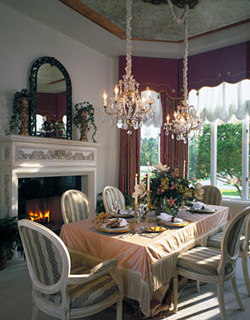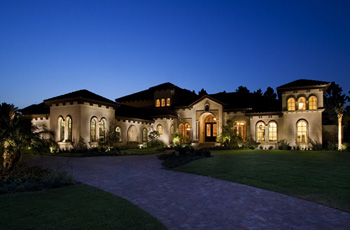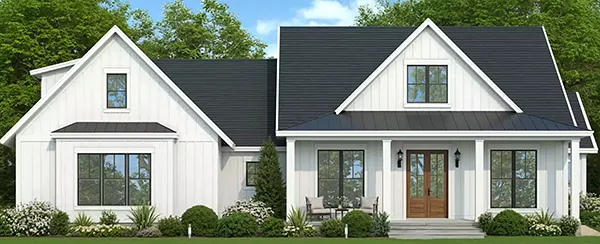Total Home Lighting Design
If you're constructing a new, energy-efficient home, you'll need to consider lighting as part of your whole-house design — inside and out. Since you're most likely purchasing all new lighting fixtures, it is a good idea to install dedicated compact fluorescent lamps. These fixtures are a great choice for accent and ambient lighting, because they achieve the same light quality of its incandescent counterparts but at a much greater savings.
The dining room in this elegant
French Country Chateau features a luxurious double chandelier. Everything about this home exclaims opulence and understated elegance.

When it comes to designing your indoor lighting for energy efficiency, you will want to consider some basic design principles and methods.
- Remember that more light is not necessarily better and that quality really matters, especially with task and ambient lighting.
- Match the amount and quality of light to the performed function.
- Install task lights where needed and reduce ambient light elsewhere.
- Use energy-efficient lighting components, controls, and systems.
- Maximize the use of natural light.
Here are some easy ways to achieve energy-efficient indoor lighting:
- Install fluorescent light fixtures for all ceiling and wall-mounted fixtures that will be on for more than two hours each day. These often include high-usage areas like the kitchen and living room, bathrooms, halls, bedrooms, and other higher-demand locations.
- Install dedicated compact fluorescent fixtures, rather than compact fluorescent lamps (CFLs) in incandescent fixtures, so that the fluorescent bulbs can be used for the life of your home.
- Be sure all your fixtures are labeled ENERGY STAR®.
- Use occupancy sensors for automatically turning on and off your lights as needed and dimmers to control the amount of light you need.
- Consider light wall colors to minimize the need for artificial lighting.
- If you use recessed lights in a ceiling with an unconditioned space above it, be sure they are Underwriters Laboratory (UL) approved fixtures that are airtight.
When it comes time to designing your outdoor lighting, you'll need to consider the purpose of the lighting along with the basic methods for achieving energy efficiency. Generally speaking, outdoor lighting serves one or more purposes, which include aesthetics to illuminate your home's exterior and landscape, security near your home's entranceway and driveway and utility to illuminate your porch, pool, patio, deck and/or driveway.
This magnificent contemporary
Mediterranean house plan is designed with exquisite interior and exterior lighting. Large windows make excellent use of natural light to maximize your home's energy efficiency.

Here are some easy ways to achieve energy-efficient outdoor lighting:
- Security and utility lighting does not need to be bright to be effective.
- Consider incandescent floodlights with combined photo sensors and motion sensors in the place of other security lighting options.
- Make sure your outdoor light fixtures have reflectors, deflectors, or covers to make more efficient use of the light source and keep them from getting weathered.
- Use timers and other controls to turn decorative lighting on and off.
- To line a driveway or pathway or outline a pool or patio, use outdoor solar lighting.







